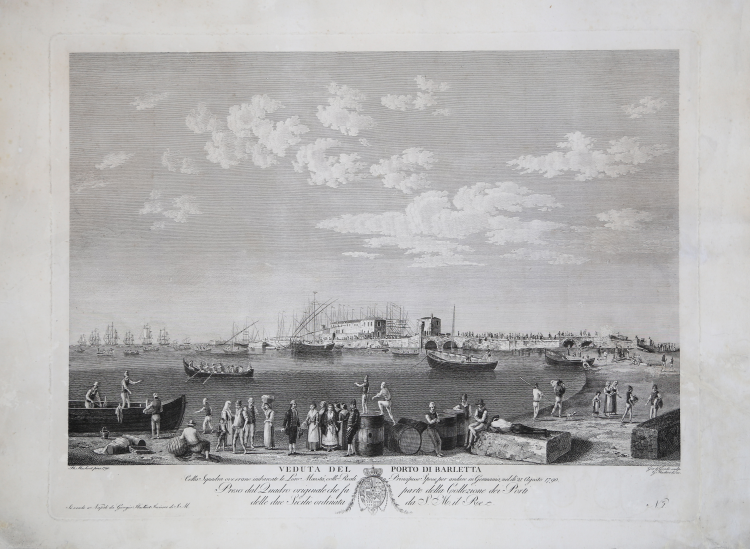



| Reference: | S46189 |
| Author | Georg Abraham HACKERT |
| Year: | 1790 ca. |
| Zone: | Barletta |
| Printed: | Naples |
| Measures: | 580 x 430 mm |


| Reference: | S46189 |
| Author | Georg Abraham HACKERT |
| Year: | 1790 ca. |
| Zone: | Barletta |
| Printed: | Naples |
| Measures: | 580 x 430 mm |
View of the harbor of Barletta. with the long pier cuts diagonally across the scene. Ships at anchor and others in the distance; small boats with men rowing inside the small harbor. In foreground figures of commoners who witnessed the departure.
Etching, last decade of the 18th century, signed by Giovanni de Grado and Georg Abraham Hackert, who translated into print and published the famous painting by his brother Jakob Philipp Hackert (1790) belonging to the series Views of the Ports of the Kingdom preserved in the Royal Palace of Caserta.
Influenced by the landscapes of Claude Lorrain and 17th-century Dutch artists, German Jakob Philipp Hackert (1737-1807) was one of the greatest landscape artists based in Rome late 18th century. His precise renderings of beautiful and historic sites attracted an international clientele during the European Grand Tour.
In 1785 at the request of King Ferdinand IV of Borbone he settled in Naples, having achieved success through a commission he received from Tsarina Catherine II of Russia (1782). At the Bourbon court, where he worked together with his engraver brother George Abraham (1755-1805), he was appointed First Court Painter with the task of painting the views dearest to the king, advising him on the purchase of works of art, and dealing with the artistic education of the princes. In addition, Hackert oversaw for the king the transport of the Farnese Collection from Rome to Naples, the restoration of paintings in the Royal Picture Gallery, and the decoration of the new royal sites of San Leucio and Carditello.
The painter had not yet completed the series of the first of the paintings requested of him when the king, in 1788, ordered him to travel to Apulia to make an overall topographical survey of the Adriatic coast, with its bays and ports. Between 1789 and 1792 Hackert drew at least nine views from it, starting from the Gulf of Manfredonia, going down to the heel of the boot, and then up the Ionian Sea toward Taranto. A corpus of preparatory studies for the large-format canvases of the suite of ports of the kingdom, now preserved at the Kupferstichkabinett in Berlin, testifies to the painstaking and thorough work underlying the creation of the views and gives an account of the numerous graphic proofs that preceded the drafting of the paintings.
The Royal Palace of Caserta holds many of his works in its Collections, including the Views of the Ports of the Kingdom, commissioned for the Villa Favorita in Resina and which became the model for an entire Neapolitan school of painters for landscapes from life.
The views were printed in Naples by Georg Abraham Hackert, who directed and commissioned his pupil Giovanni de Grado to do the engraving.
Beautiful proof, printed on paper datable to the early 19th century, restored tear in the right side, traces of glue and restorations visible on the verso, overall in good condition.
Bibliografia
Il paesaggio secondo natura, Jacob Philipp Hackert e la sua cerchia, A cura di: Paolo Chiarini; A. Grimaldi, Le Vedute dei Porti del Regno: Jacob Philipp Hackert, Il vedutista al servizio del Re, pp- 313-335.
Georg Abraham HACKERT (Prenzlau, 1755; Firenze, 1805)
|
Brother of Philipp Hackert. He trained in Berlin with F. G. Berger and went to Italy in 1776 at the invitation of his elder brother Philipp. Though his training was based mainly on 17th-century Dutch and Flemish art, he was soon influenced by the Neo-classical theories of Winckelmann and Mengs. His work in Rome compromises effectively between a calligraphic approach and the Romantic spirit. In fact, while faithfully rendering his brother’s landscapes, he managed to infuse a new sense of nature into his engravings. He had the ability to illustrate a scene as if engraving from life rather than from a painting. Georg did most of his work in Naples, where the Bourbon court appointed him official engraver. In this position he was an upholder and propagator of Neo-classical theories, but his influence on Neapolitan engraving, especially through his renderings of his brother’s great canvases of Ports of the Realm, remains to be studied. He fled Naples with his brother in 1799.
|
Georg Abraham HACKERT (Prenzlau, 1755; Firenze, 1805)
|
Brother of Philipp Hackert. He trained in Berlin with F. G. Berger and went to Italy in 1776 at the invitation of his elder brother Philipp. Though his training was based mainly on 17th-century Dutch and Flemish art, he was soon influenced by the Neo-classical theories of Winckelmann and Mengs. His work in Rome compromises effectively between a calligraphic approach and the Romantic spirit. In fact, while faithfully rendering his brother’s landscapes, he managed to infuse a new sense of nature into his engravings. He had the ability to illustrate a scene as if engraving from life rather than from a painting. Georg did most of his work in Naples, where the Bourbon court appointed him official engraver. In this position he was an upholder and propagator of Neo-classical theories, but his influence on Neapolitan engraving, especially through his renderings of his brother’s great canvases of Ports of the Realm, remains to be studied. He fled Naples with his brother in 1799.
|